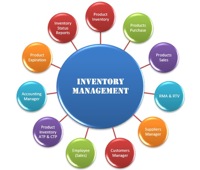Li Liang, Doctoral student. Email lli91@vt.edu
Inventory management is an indispensable part in the supply chain management, since it covers the aspect of logistics, operations, marketing, finance, and information systems (Sprague, Sardy, 2009). For example, in the aspect of finances, the inventory management may associate with item, carry, ordering, stock out, and capacity associated costs ( Arnold et al. 2008). In relationship to operations, inventory management need to manage the stock at an optimal level and determine the quality of this inventory to satisfy the needs of manufacturing and customer demands (Bayraktar, 2012). In terms of marketing and information system aspects, inventory management may relate to the demand forecasting and information sharing (Smart, 2008).

The schematic shown in Fig. 1 gives a more directly and comprehensive oversee of inventory management. Inventory management takes part in the whole value-added chain. Perhaps the most significant subject of research in inventory management is to understand how to manage stock. Yue (2002) constructed two models derived from a pipeline hedging method to evaluate the reduction of safety stock when redesigning a manufacturing process. Model one was used to study the product family with one product and focused on operation re-sequencing; while model two was used to study the product family with two products and focused on merging of operation. The result showed that both the merging and re-sequencing could significantly minimize the safety stock level.
Singh and Kumat (2011) proposed an efficient method based on the Genetic Algorithm to determine the most probable shortage level and additional stock level for inventory optimization in supply chain so that the total cost could be minimized. Liou et al (2013) introduced the Stackelberg equilibrium framework with the objective of maximizing the total benefit for vendors and with the restriction of minimizing the total cost to an acceptable level when studying one seller, one buyer, finite horizon, and multi-period inventory model. Liou concluded that the Stackelburg equilibrium could obtain the optimal condition and optimal replenishment policy, and the optimal replenishment policy could be found by a numerical algorithm.
Mekel (2014) used a quantitative method of forecasting calculation with double exponential smoothing models to predict the level of demand from 2013 to 2014, through deciding the safety level and re-order point to know how much inventory should be anticipated and when should be ordered, also, the author used Economic Order Quantity calculation to know the amount of orders of raw material at the lowest cost.
In conclusion, inventory management is still playing an important role in supply chain management. And much of the current literature focus on using innovative method to forecast and lower safety stock level. The future research may continue study the innovative methodologies to obtain the optimal condition for the supply chain management problem.
References
- Sprague, L.G; Sardy, M.J. (2009) Some surprising new about classical view on inventory and some nonclassical responses to traditional practice. Inventory management, 2 (2009) 25-30
- Arnold, T; Chapman, S; Clive, L. (2008). Introduction to materials management. New jersey: Pearson Education.
- Bayraktar, E; Ludkovski, M. (2010). Inventory management with partially observed non-stationary demand. Annals of operation research, 176 (2010) 7-39
- Liou Y.C; Schaible, S; Yao J.C. (2013). Supply chain inventory management via a Stackelberg equilibrium. Journal of industrial and management optimization, 9 (2013) 81-83
- Smart, C.N. (2008). The Relationship Between Forecasting and Optimal Stocking Levels. APICS-The Performance Advantage.
- Singh, S.R; Kumar, T. (2011). Inventory optimization in efficient supply chain management. International journal of computer applications in engineering science. 1 (2011) 428-433
- Yue, X.H. (2002). Emerging problems in supply chain management, (2002) 10-94
- Mekel, C; Anantadjaya, S; Lahindah, L. (2014). Stock Out Analysis: An Empirical Study on Forecasting, Re-Order Point and Safety Stock Level at PT. Combiphar, Indonesia. Review of Integrative Business and Economics Research, 3 (2014) 52-64
